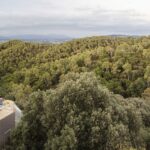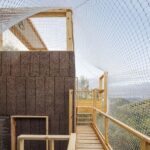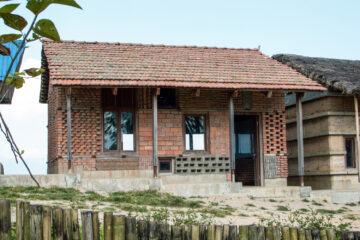FLORA Observatory: Advancing Ecological Research

FLORA, an innovative ecological observatory, emerges within the Collserola Natural Park in Barcelona, crafted by a collaborative effort of students and researchers from the “Master in Advanced Ecological Buildings and Biocities” (MAEBB).

Constructed with wood sourced from sustainably managed forests in the vicinity, FLORA serves as a research hub, enabling scientists to reside and work amidst the forest canopy. Inspired by the forest walkways pioneered by American biologist Margaret D. Lowman, known as Canopy Meg, the project by the Catalan Institute of Advanced Architecture (IAAC) offers a versatile installation for nature monitoring adaptable to forests worldwide.
FLORA, acronym for “Forest Lab for Observational Research and Analysis,” stands tall in Valldaura, nestled within the Collserola Natural Park. Rising over 8.5 meters, the structure embodies a commitment to sustainability, utilizing locally sourced pine trees processed into cross-laminated timber panels, laminated beams, and solid wood elements. MAEBB master’s program participants meticulously handled the seventy trees, ensuring a rigorous process of wood traceability.
Situated within the expansive Collserola Park, FLORA addresses the conservation challenges facing Mediterranean forests, particularly amid prolonged droughts and the impacts of climate change. It stands as the first structure facilitating observation of the forest canopy and ecosystem evolution, fostering invaluable insights for ecological preservation.

The project embodies the “kilometer zero” philosophy, from its inception to execution. By utilizing wood harvested from the local environment, FLORA minimizes its ecological footprint, supporting sustainable forest management practices crucial for biodiversity conservation.
Seventy pine trees were carefully selected, felled, and processed to supply the requisite construction materials. The resulting cross-laminated timber panels, laminated beams, and solid wood components form the foundation of FLORA’s structure, resting atop four glued laminated wood pillars. These elements were meticulously assembled, with the CLT structure enveloped in two layers of natural cork panels for thermal and acoustic insulation.
Embracing nature-inspired design, FLORA features a net surrounding the building, mirroring the nests of local fauna and fostering integration with the surrounding forest landscape. This camouflaging technique encourages plant growth, blending the structure seamlessly into its natural surroundings.

FLORA serves as a haven for scientific inquiry, offering researchers a temporary abode to study local biodiversity and observe the impacts of climate change. Equipped with ornithological tools, workspaces, and interactive elements, the observatory fosters an immersive ecological experience, echoing the pioneering spirit of forest canopy exploration championed by Canopy Meg.
In essence, FLORA Observatory stands as a testament to sustainable architecture and ecological research, poised to advance our understanding of forest ecosystems and inform conservation efforts for generations to come.



























